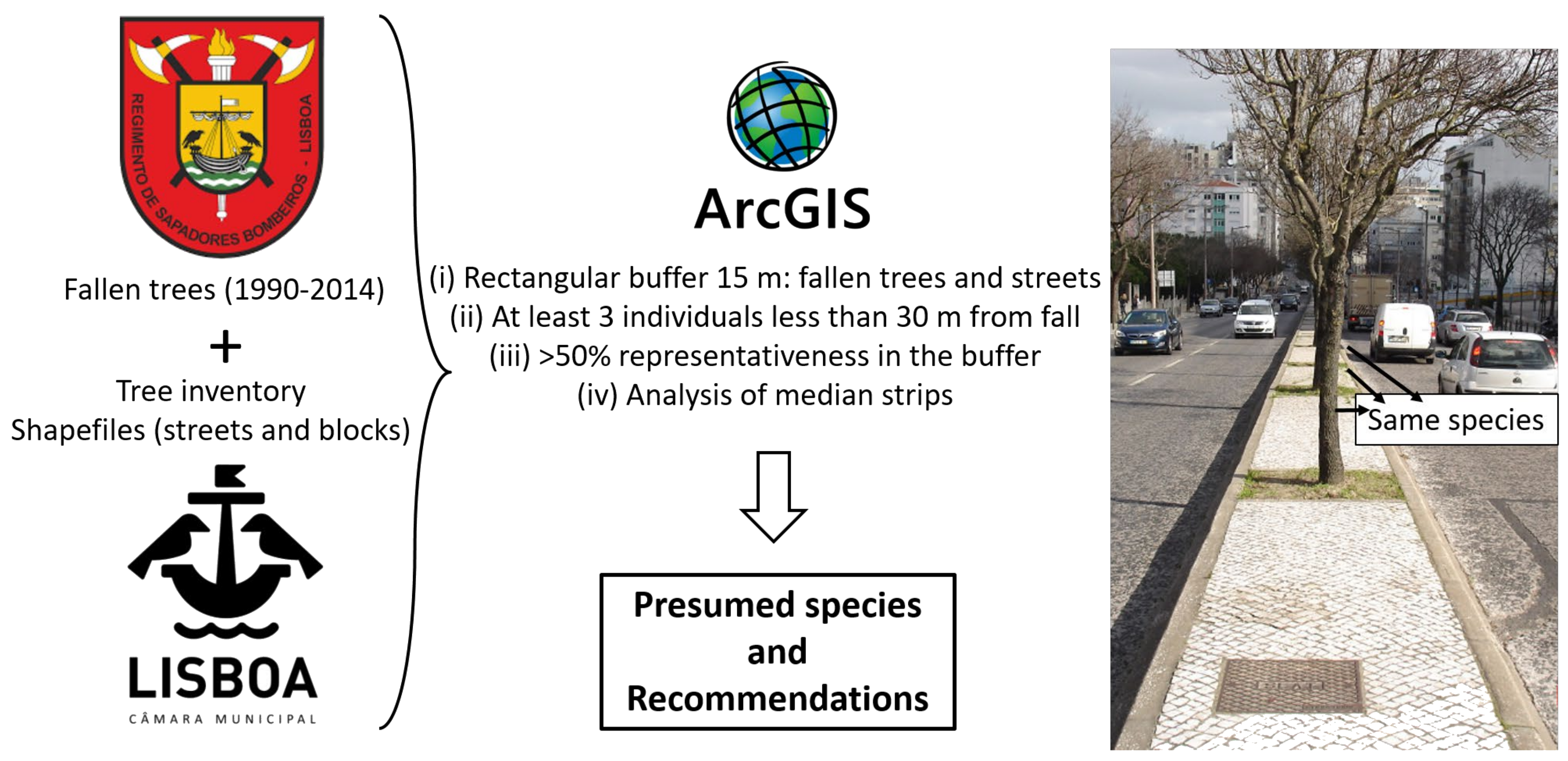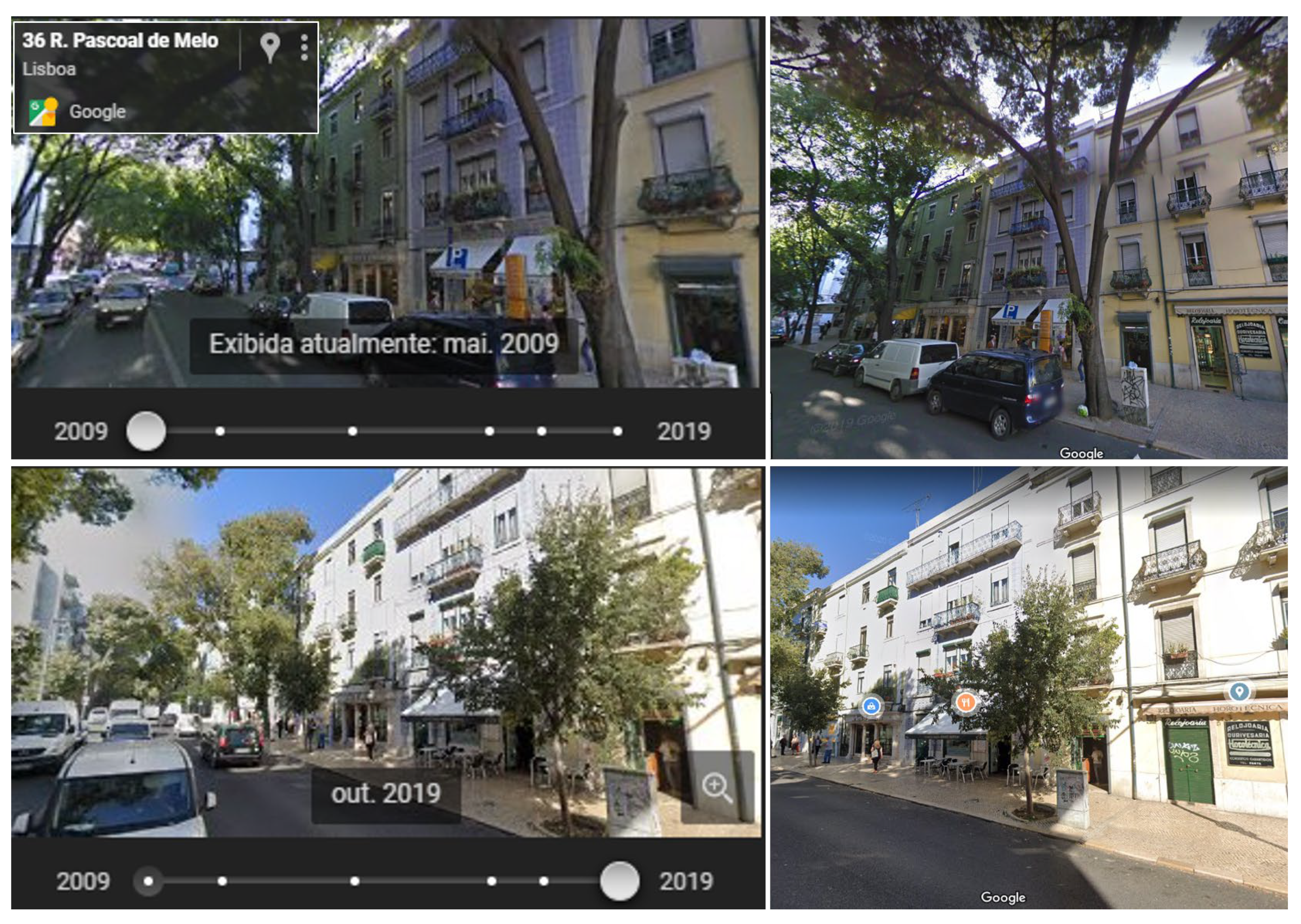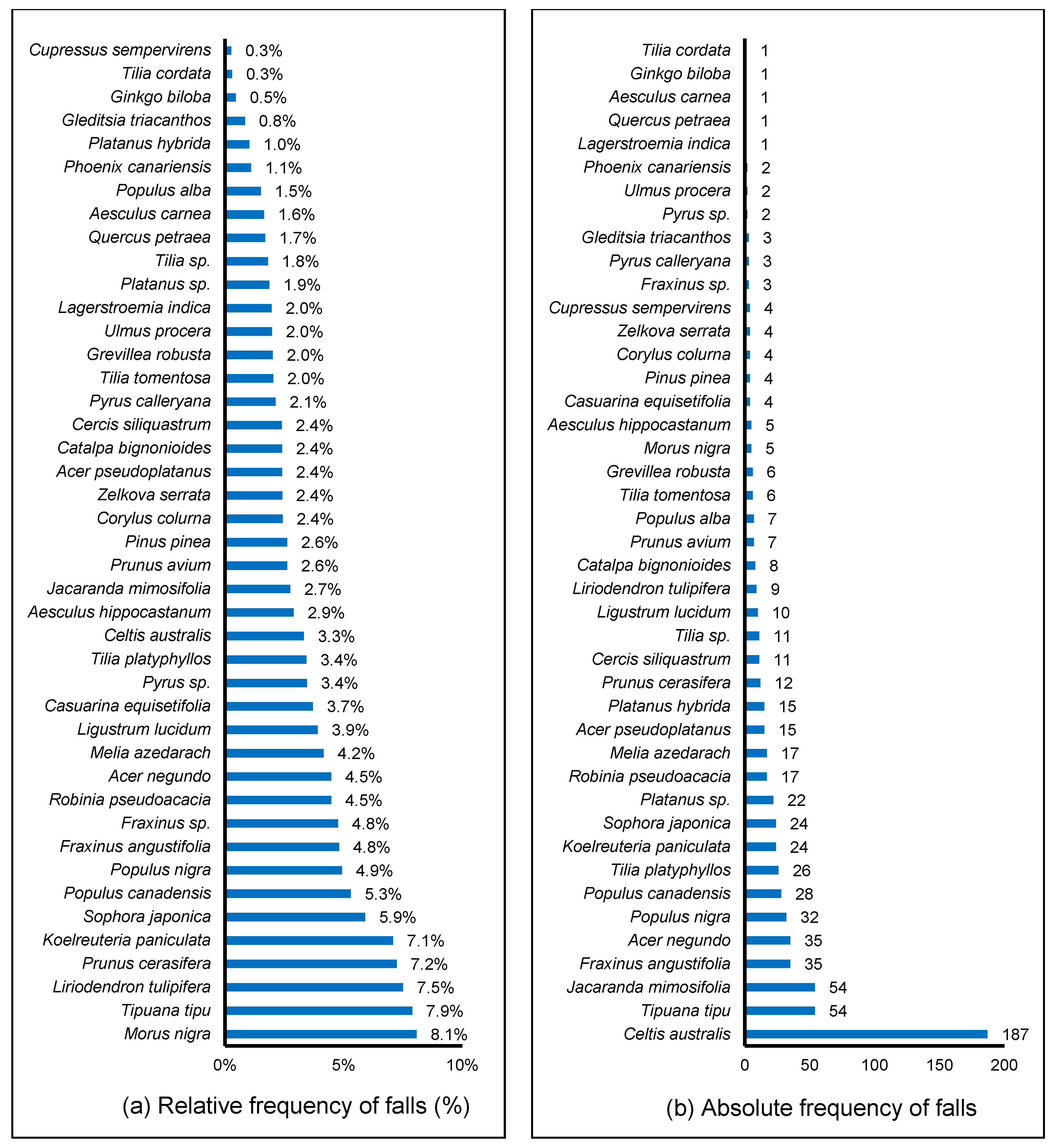A Proximity-Based Approach for the Identification of Fallen Species of Street Trees during Strong Wind Events in Lisbon
Abstract
1. Introduction
2. Materials and Methods
2.1. Study City
2.2. Workflow Chart
2.3. Unknown Tree Species Determination by Proximity
3. Results
4. Discussion
Author Contributions
Funding
Data Availability Statement
Acknowledgments
Conflicts of Interest
References
- McPherson, G.; Simpson, J.R.; Peper, P.J.; Maco, S.E.; Xiao, Q. Municipal forest benefits and costs in five US cities. J. For. 2005, 103, 411–416. [Google Scholar] [CrossRef]
- Burden, D. Urban Street Trees: 22 Benefits Specific Applications; Glatting Jackson and Walkable Communities Inc.: Orlando, FL, USA, 2006; pp. 1–21. [Google Scholar]
- Andrade, H.; Vieira, R. A climatic study of an urban green space: The Gulbenkian Park in Lisbon (Portugal). Finisterra 2007, 42, 27–46. [Google Scholar] [CrossRef]
- Goddard, M.A.; Dougill, A.J.; Benton, T.G. Scaling up from gardens: Biodiversity conservation in urban environments. Trends Ecol. Evol. 2010, 25, 90–98. [Google Scholar] [CrossRef] [PubMed]
- Roy, S.; Byrne, J.; Pickering, C. A systematic quantitative review of urban tree benefits, costs, and assessment methods across cities in different climatic zones. Urban. For. Urban. Green. 2012, 11, 351–363. [Google Scholar] [CrossRef]
- Reis, C.; Lopes, A. Evaluating the Cooling Potential of Urban Green Spaces to Tackle Urban Climate Change in Lisbon. Sustainability 2019, 11, 2480. [Google Scholar] [CrossRef]
- Santamour Júnior, F.S. Trees for urban planting: Diversity uniformity, and common sense. In Proceedings of the VII Metropolitan Tree Improvement Alliance, Lisle, IL, USA, 11 June 1990. [Google Scholar]
- Lisbon City Hall. Vinte e Cinco Árvores de Lisboa; CML, DMAU, DAEV: Lisbon, Potugal, 2019; pp. 1–32. [Google Scholar]
- Soares, A.L.; Castel-Branco, C. As árvores da cidade de Lisboa. In Floresta e Sociedade: Uma História em Comum; Silva, J.S., Ed.; Flad: Lisbon, Portugal, 2007; pp. 289–334. [Google Scholar]
- Soares, A.L.; Rego, F.C.; McPherson, E.G.; Simpson, J.R.; Peper, P.J.; Xiao, Q. Benefits and costs of street trees in Lisbon, Portugal. Urban. For. Urban. Green. 2011, 10, 69–78. [Google Scholar] [CrossRef]
- Lopes, A.; Mendes, F.; Correia, E. Street trees vulnerability to strong wind events in Lisbon: Meteorological and phytosanitary assessment to mitigate urban hazards. In Proceedings of the International Conference on Urban Risks, Lisbon, Portugal, 30 June 2016. [Google Scholar]
- Lopes, A.; Oliveira, S.; Fragoso, M.; Andrade, J.; Pedro, P. Wind risk assessment in urban environments: The case of falling trees during windstorm events in Lisbon. In Bioclimatology and Natural Hazards; Střelcová, K., Mátyás, C., Kleidon, A., Lapin, M., Matejka, F., Blaženec, M., Škvarenina, J., Holécy, J., Eds.; Springer: Dordrecht, The Netherlands, 2009; pp. 55–74. [Google Scholar]
- Ribeiro, P.; Lopes, A. Modelação do risco de queda de árvores sobre as viaturas devido a ventos fortes em Lisboa. In Proceedings of the VIII Congresso da Geografia Portuguesa, Lisbon, Portugal, 29 October 2011. [Google Scholar]
- Mattheck, C.; Breloer, H. The Body Language of Trees: A Handbook for Failure Analysis; The Stationery Office: London, UK, 1997; pp. 1–320. [Google Scholar]
- Albers, J.S.; Pokorny, J.D.; Johnson, G.R. How to detect and assess hazardous defects in trees. In Urban Tree Risk Management: A Community Guide to Program Design and Implementation; Pokorny, J.D., Ed.; USDA Forest Service: Saint Paul, MN, USA, 2003; pp. 41–116. [Google Scholar]
- Lopes, A.; Oliveira, S.; Fragoso, M. Vento forte e queda de árvores em Lisboa: Avaliação e primeiros resultados. In Estudos sobre Cidades e Alterações Climáticas; Alcoforado, M.J., Andrade, H., Fragoso, M., Lopes, A., Lombardo, M., Matzarakis, A., Oliveira, S., Eds.; Centro de Estudos Geográficos: Lisbon, Portugal, 2008; pp. 71–91. [Google Scholar]
- Hou, G.; Chen, S. Probabilistic modeling of disrupted infrastructures due to fallen trees subjected to extreme winds in urban community. Nat. Hazards 2020, 102, 1323–1350. [Google Scholar] [CrossRef]
- National Institute of Statistics (INE). Available online: http://www.cm-lisboa.pt/municipio/demografia (accessed on 27 November 2020).
- IPMA. Available online: http://www.ipma.pt/bin/file.data/climate-normal/cn_71-00_LISBOA_GAGO_COUTINHO.pdf (accessed on 18 December 2020).
- Sæbø, A.; Borzan, Z.; Ducatillion, C.; Hatzistathis, A.; Lagerström, T.; Supuka, J.; García-Valdecantos, J.L.; Rego, F.; Van Slycken, J. The selection of plant materials for street trees, park trees and urban woodland. In Urban Forests and Trees; Konijnendijk, C., Nilsson, K., Randrup, T., Schipperijn, J., Eds.; Springer: Berlin/Heidelberg, Germany, 2005; pp. 257–280. [Google Scholar]
- Ducatillion, C.; Dubois, E. Diversification des plantes ornementales méditerranéennes: Estimation des besoins qualitatifs des villes en arbres et arbustes. In La Plante Dans la Ville; Rivière, L.M., Ed.; INRA: Angers, France, 1997; pp. 139–149. [Google Scholar]
- Rego, F.C.; Castel-Branco, C. A escolha das espécies: Da lista referencial às plantações experimentais. In O Livro Verde; Castel-Branco, C., Rego, F.C., Eds.; Expo’98: Lisbon, Portugal, 1998; pp. 71–85. [Google Scholar]
- Lagerström, T.; Eriksson, G. Improvement of trees and shrubs by phenotypic selection for landscaping in urban and rural areas—A Swedish example. For. Landsc. Res. 1996, 1, 349–366. [Google Scholar]
- De Vries, S.M.G.; Van Dam, B.C. Selection programme of oak in The Netherlands. In Diversity and Adaptation in Oak Species; Steiner, K.C., Ed.; University Park: Philadelphia, PA, USA, 1998; pp. 201–208. [Google Scholar]
- Koeser, A.K.; Smiley, E.T.; Hauer, R.J.; Kane, B.; Klein, R.W.; Landry, S.M.; Sherwood, M. Can professionals gauge Likelihood of failure?—Insights from tropical storm Matthew. Urban. For. Urban. Green. 2020, 52, 126701. [Google Scholar] [CrossRef]
- Andresen, M.T.L.M.B. Árvores de Arruamento de Lisboa, Contribuição Para a sua Classificação. Undergraduation, Landscape Architecture. Bachelor Thesis, Instituto Superior de Agronomia, Universidade Técnica de Lisboa, Lisbon, Portugal, 1982. [Google Scholar]
- Brazolin, S. Biodeterioração, Anatomia do Lenho e Análise de Risco de Queda de Árvores de Tipuana, Tipuana Tipu (Benth.) O. Kuntze, nos Passeios Públicos da Cidade de São Paulo, SP. Ph.D. Thesis, Forest Resources, Escola Superior de Agricultura “Luiz de Queiroz”, Universidade de São Paulo, São Paulo, Brazil, 2009. [Google Scholar]
- Mendes, F.H.; Polizel, J.L.; Silva Filho, D.F. O efeito do vento nas quedas de árvores em Piracicaba/SP. Ciên. Nat. 2016, 38, 1523–1535. [Google Scholar] [CrossRef][Green Version]
- Mailliet, L.; Bourgery, C. L’ Arboriculture Urbaine; Institut pour le Développement Forestier: Crécy-Couvé, France, 1993; pp. 1–318. [Google Scholar]
- Konijnendijk, C.C. Evidence-based guidelines for greener, healthier, more resilient neighbourhoods: Introducing the 3-30-300 rule. J. For. Res. 2023, 34, 821–830. [Google Scholar] [CrossRef] [PubMed]








Disclaimer/Publisher’s Note: The statements, opinions and data contained in all publications are solely those of the individual author(s) and contributor(s) and not of MDPI and/or the editor(s). MDPI and/or the editor(s) disclaim responsibility for any injury to people or property resulting from any ideas, methods, instructions or products referred to in the content. |
© 2024 by the authors. Licensee MDPI, Basel, Switzerland. This article is an open access article distributed under the terms and conditions of the Creative Commons Attribution (CC BY) license (https://creativecommons.org/licenses/by/4.0/).
Share and Cite
Mendes, F.H.; Petean, F.C.d.S.; Correia, E.L.T.; Lopes, A.M.S. A Proximity-Based Approach for the Identification of Fallen Species of Street Trees during Strong Wind Events in Lisbon. Land 2024, 13, 708. https://doi.org/10.3390/land13050708
Mendes FH, Petean FCdS, Correia ELT, Lopes AMS. A Proximity-Based Approach for the Identification of Fallen Species of Street Trees during Strong Wind Events in Lisbon. Land. 2024; 13(5):708. https://doi.org/10.3390/land13050708
Chicago/Turabian StyleMendes, Flávio Henrique, Felipe Coelho de Souza Petean, Ezequiel Luís Tavares Correia, and António Manuel Saraiva Lopes. 2024. "A Proximity-Based Approach for the Identification of Fallen Species of Street Trees during Strong Wind Events in Lisbon" Land 13, no. 5: 708. https://doi.org/10.3390/land13050708
APA StyleMendes, F. H., Petean, F. C. d. S., Correia, E. L. T., & Lopes, A. M. S. (2024). A Proximity-Based Approach for the Identification of Fallen Species of Street Trees during Strong Wind Events in Lisbon. Land, 13(5), 708. https://doi.org/10.3390/land13050708










